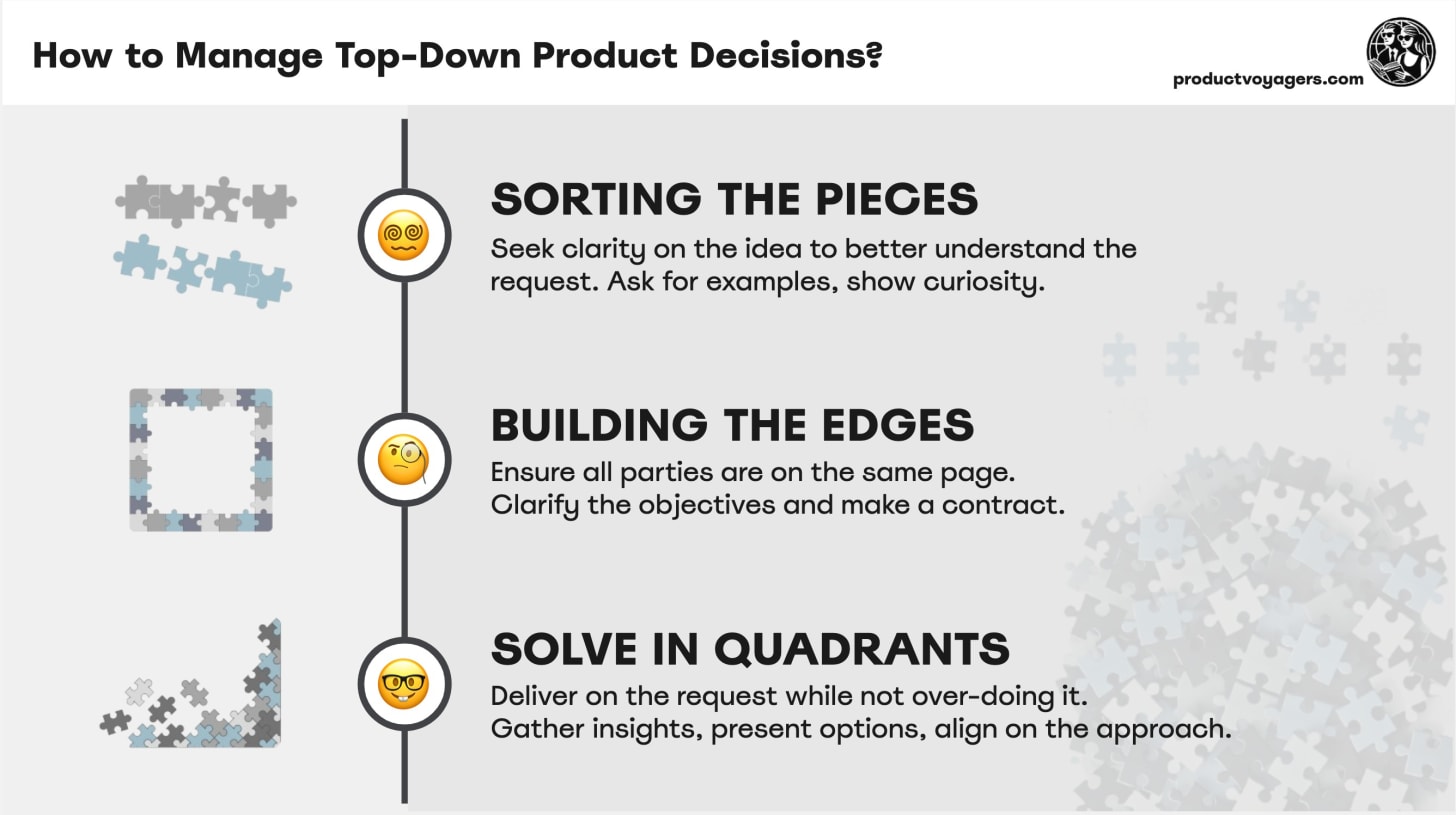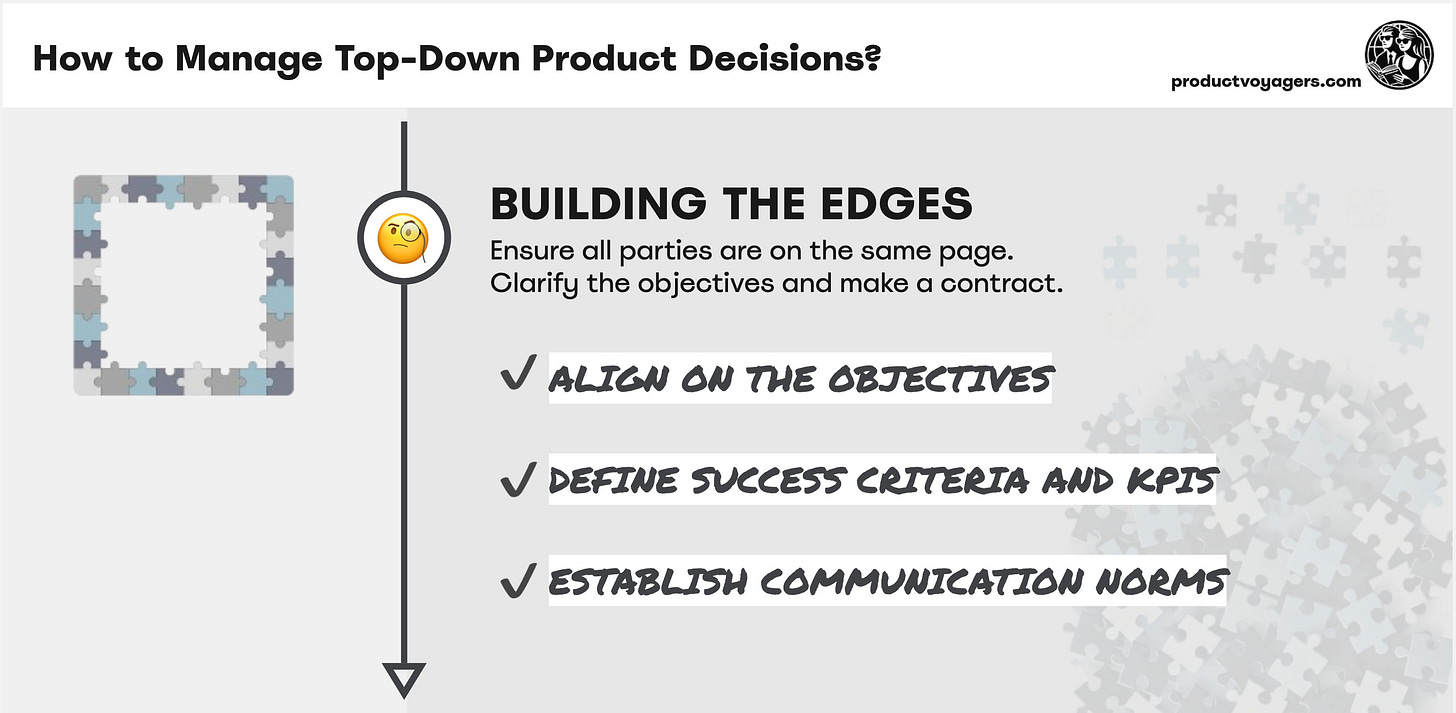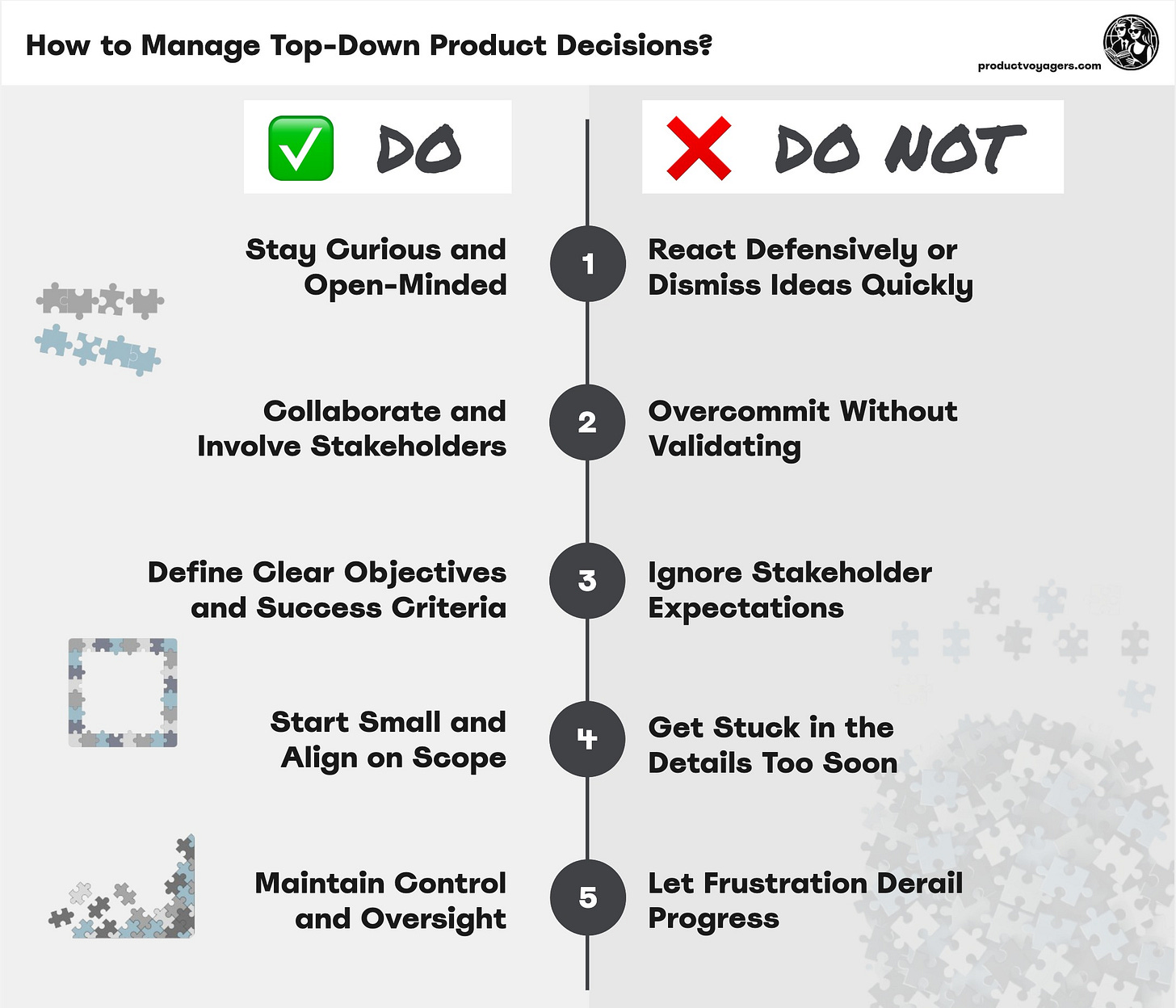Mastering Top-Down Decisions: A Puzzle-Solving Framework for Product Managers
Managing top-down decisions isn’t easy—we’ve all been there. I’ve put together a framework from my experiences to make it simpler for you. Check it out and see what resonates!
In my previous post, I explored the challenges Product Managers face when dealing with top-down decisions—those directives handed down by superiors, senior leadership in non-product roles, or even business owners. As we know, these decisions can be tricky, particularly when they lack a user-centric focus or don’t align with the overall strategy.
Let’s face it: no matter how skilled we are at negotiating, there will be times when we have no choice but to accept a top-down decision. The other side will stand firm, convinced their view is the right one.
In this article, I’m going to take it a step further and provide a concrete framework that Product Managers can follow when faced with top-down decisions. Think of it like solving a puzzle. Picture a situation where someone, like David, pitches a new feature idea—one that doesn’t immediately make sense or align with your product’s goals. What’s your first reaction? Confusion? Frustration? These feelings are natural, but the key is how you handle them.
Rather than jumping straight into criticism, it’s important to approach the situation tactically. David is likely excited and convinced his idea will work. And while it may seem disconnected at first, there’s always an opportunity to align and find a way forward.
In the following sections, we’ll break down the process into 3 critical phases that will help you solve the puzzle of managing top-down decisions.
Phase 1 → Sorting the Pieces
Objective: Seek Clarity & Encourage Meaningful Dialogue.
Phase 2 → Building the Edges
Objective: Establish Common Goals
Phase 3 → Solve in Quadrants
Objective: Ensure Smooth Execution
What you’ll get in this article: A practical framework for navigating top-down decisions and guidance on how to maintain control and drive the product forward.
Solving a Puzzle
Phase 1 → Sorting the Pieces
Objective: Seek Clarity & Encourage Meaningful Dialogue.
At the start of a discussion, you may find yourself overwhelmed by a mix of ideas—especially when a stakeholder like David throws a seemingly disorganized collection of features your way. These ideas might not immediately align with the overall strategy, or they might be difficult to piece together. This is where Phase 1 comes in—sorting through the chaos and seeking clarity before diving deeper into the decision-making process.
A. Pause & Explore
Your first reaction sets the tone for the entire conversation—and the relationship moving forward. How you respond now determines your ability to control the situation in later phases. Rather than rushing to defend your current strategy or challenge the idea right away, take a moment to understand the underlying motivations behind the request. By responding with curiosity, you create a productive dialogue, not a defensive one.
✅ Approach:
Resist the urge to reject: Don't dismiss the idea immediately. Take time to understand it.
You mentioned that your wife is using a similar app. What features do you think could work for our users?
Use open-ended questions: Encourage the stakeholder to elaborate and provide more context.
Can you walk me through how you envision this feature working in practice?
Acknowledge and validate input: Recognize the stakeholder's enthusiasm or reasoning to foster a positive discussion.
Encourage collaboration: Frame the conversation as a partnership, especially if others are present—get their input too.
Diana, I recall you using a similar app. How did it work for you?
Listen actively and take notes: This shows you value their input and helps you organize your thoughts for the next steps.
B. Identify Gaps & Invite Collaboration
It’s normal to have concerns or uncertainties about how the new feature fits into the product vision or user needs. At this point, raise these concerns constructively. This is an opportunity to gather more data or perspectives before making any final decisions. If necessary, invite others to help explore these gaps and refine the approach.
✅ Approach:
Involve other stakeholders: If needed, suggest bringing in team members who can offer missing insights or perspectives.
Frame concerns constructively: Instead of just pointing out issues, suggest areas that need further research or clarification.
We’re missing some key insights from user testing in this area. Could we prioritize collaborating with the research team to fill in these gaps?
Collaborate on solutions: Show willingness to work with the stakeholder or their team to address gaps in knowledge and strengthen the idea.
C. Reflect & Align on Next Actions
Once you’ve gathered all the relevant information, it’s important to rephrase and summarize the discussion. This ensures you’ve captured the essence of the idea and that both sides are aligned on next steps. Rephrasing not only demonstrates that you’ve been listening, but it also gives the stakeholder a chance to clarify any misunderstandings.
✅ Approach:
Confirm mutual understanding: Paraphrase key points to ensure both sides are aligned and no critical details are overlooked.
Clarify next steps: Reconfirm actions, responsibilities, and timelines to ensure clarity.
Ensure clear ownership: Define who will be responsible for each step to avoid confusion later.
Set a follow-up plan: Confirm the next steps with deadlines to maintain momentum.
To recap, we’re considering a feature to address user pain point X, inspired by Z competitor’s approach. The next steps are analyzing competitor strategies and gathering user feedback. This will help us define objectives and determine how to measure success. I’ll follow up with a progress update next week.
❌ DO NOT:
Let frustration or impatience influence your response: Stay calm, open, and curious to maintain a productive conversation.
Prematurely reject an idea: Even if it feels off-track at first, you could miss valuable insights or opportunities for improvement.
Rush into committing to deliverables: Focus on understanding the idea fully before committing to specific outcomes.
Insist on data right away: Most stakeholders may not have data to support their ideas early on—avoid challenging them on this.
Raise concerns about capacity or effort too soon: Focus on understanding the idea before diving into execution details.
Phase 2 → Building the Edges
Objective: Establish Common Goals
In Phase 1, you sorted the pieces, gaining clarity on the idea. Now, you need to take the next step: aligning on a shared vision. In this phase, you’ll define clear objectives, success criteria, and communication processes. The idea may still feel a little fuzzy, but now is the time to refine it, ensuring you’re all aligned on what success looks like before you start building.
A. Align on the Objectives
It’s crucial to take time to fully understand the objectives behind the feature. This is the phase where you and the stakeholder must ensure you are working toward the same target, even if you don’t agree on every detail. Clarifying the high-level objectives now will help focus the team’s efforts and keep the feature aligned with both business and user goals.
✅ Approach:
Align the vision: Make sure you understand the overall purpose of the feature and how it fits within the larger strategy.
Identify core objectives: Focus on defining the core goals, especially the business and user problems the feature will solve.
Seek clarification when needed: Don’t hesitate to ask for more details if the objectives seem unclear or conflicting.
Revisit previous discussions: Refine objectives based on earlier discussions, ensuring they evolve logically from Phase 1.
B. Define Success Criteria
By defining success early on, you ensure that all stakeholders are on the same page regarding what success looks like. Clear success metrics will help guide the development process and give you a way to assess whether the feature is meeting its goals.
✅ Approach:
Collaborate to define KPIs: Work with the team to define measurable KPIs that align with both business and user objectives.
Set clear expectations: Ensure the stakeholder understands how success will be tracked and the timeline for assessment.
Balance short- and long-term success: Consider both immediate performance and long-term strategic alignment.
Document the success criteria: Capture agreed-upon success metrics for easy reference throughout the development process.
C. Establish Communication Norms
Creating a "contract" in this phase means establishing the practical terms of collaboration. It’s about setting expectations for communication, updates, and documentation throughout the project. This ensures that everyone involved is on the same page about how information will be shared, how often, and through which channels.
✅ Approach:
Agree on communication methods: Decide on preferred channels (e.g., Slack, email, or meetings) for ongoing communication.
Set update expectations: Define how often stakeholders expect to be updated on progress and which format (e.g., written reports, presentations, meetings).
Document the process: Ensure key decisions, milestones, and action points are well-documented and accessible.
Clarify roles and responsibilities: Define who will be involved in decision-making and approvals to avoid delays.
❌ DO NOT:
Rush through objective clarification: Don’t skip over the initial steps of aligning on goals. Rushing this phase can lead to misunderstandings later in the process.
Overpromise on success criteria: Avoid making unrealistic promises about what success will look like, especially if you haven’t had enough time to properly validate the idea.
Allow communication breakdowns: Failing to set clear communication expectations can result in misalignment and missed opportunities.
Avoid tough conversations: If something doesn’t align with the objectives or success measures, speak up early rather than waiting until it's too late to course-correct.
Forget to track progress: Without clear documentation and regular check-ins, it’s easy to lose focus on key milestones.
Phase 3 → Solve in Quadrants
Objective: Ensure Smooth Execution
As a Product Manager, your role is to guide the development process without losing sight of the bigger picture. You need to maintain control while avoiding unnecessary scope creep and ensure the feature is developed efficiently. This phase is all about balancing oversight with flexibility, making informed decisions, and ensuring that the development team stays aligned with both user needs and business objectives. You’ll move forward, but in a controlled, step-by-step manner.
A. Gather Insights
Before diving deeper into development, gather insights that validate or refine your approach. Whether through user research, competitor analysis, or existing data, ensure that the feature will meet the real needs of users and align with the broader product strategy.
✅ Approach:
Use both qualitative and quantitative data: Combine user surveys, interviews, and analytics to get a comprehensive view.
Start small and iterate: Conduct targeted user testing or research to refine the idea before committing fully.
Align with stakeholders: Make sure the insights align with the business goals and user needs before proceeding.
B. Evaluate Solutions
Now that you’ve gathered insights, it’s time to decide how to move forward. Do you build the feature in-house or find a third-party solution? This decision can affect the speed of delivery, cost, and how well the solution integrates with your product. Weigh the pros and cons of each option and make sure you’re presenting a balanced view to stakeholders.
✅ Approach:
Evaluate both options thoroughly: Present the pros and cons of buying versus building, considering time, cost, resource allocation, scalability and integration challenges.
Collaborate with the team: Get input from engineers, designers, and other relevant roles to make the most informed decision.
Keep the user in mind: Ensure that whatever decision you make best serves the needs of your users and the overall product vision.
C. Set the Plan
At this point, you need to decide how to approach the development of the feature. Will you build an MVP to test the waters first? Will you run an experiment to gather feedback before going full-scale? This phase is about making sure the feature is validated before full-scale commitment.
✅. Approach:
Present a clear, documented plan: Outline the MVP approach, key milestones, and the plan for experimentation. Ensure the plan is actionable and aligned with previous phases.
We'll start with an MVP focusing on X, Y, and Z, then gather feedback through A/B testing.
Base the plan on earlier insights: Ensure the plan reflects the objectives and success criteria from Phase 1 and Phase 2, ensuring alignment with user needs and business goals.
Ensure stakeholder awareness of data: Highlight that decisions will be based on data and user feedback, guiding future iterations or pivots.
Agree on when to stop investing: Align on exit criteria—set a timeline and metrics for when to pause or pivot if the feature isn’t delivering results.
If we don’t see a 10% improvement in engagement after 4 weeks, we’ll pause and reassess.
❌ DO NOT:
Overcommit to a large scope too early: Don’t rush to build the full feature. Let the MVP or experiment inform your next steps.
Neglect user feedback: Don’t overlook the importance of validating assumptions early. This can save significant resources and prevent wasted development.
Rush into building without considering options: Don’t just assume that building in-house is the best approach. Carefully consider whether a third-party solution might be a better fit.
Forget to check for alignment: Ensure that stakeholders are aligned on the MVP approach, success metrics, and future iteration plans before moving forward.
Ignore long-term impact: Don’t focus only on short-term results. Think about how the decisions you make now will affect the product’s growth and scalability in the future.
Let’s summarize ;)








